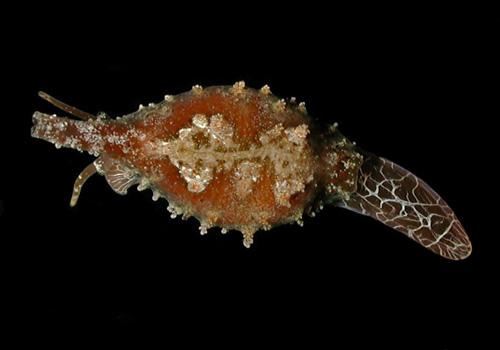| Home |
| Acknowledgments |
| Conventions |
| Glossary |
| Maps |
| References |
| Links |
| Articles |
| Thumbnails |
| Species
list |
| Family |
| Next
species |
Additional Photos

underside

side

front

shell exposed

in field

young

shell

shell size
_______________
GALLERY

Trivirostra edgari (Shaw, 1909)

| Maximum size: 9 mm shell length (Severns, 2011). Identification: In mature animals, the mantle is rust-red blotched with brown and flecked with white. It's studded with retractile, compound tubercles. The body is translucent orange and its upper surface is irregularly reticulated with white. Shells are white and typically larger (and with a higher profile) than in the similar-appearing Trivirostra hordacea. The apical margin is usually straight to slightly concave and there is usually some sign of axial sculpture between the ribs. Size at maturity is variable (5-9 mm shell length based on my material and Severns, 2011). Natural history: Trivirostra edgari is a moderately common species in moderately exposed to exposed rocky habitats and Halimeda kanaloana beds from 3-30 m (10-98 ft). Distribution: Big Island, Maui, Oahu, Kauai and Maro Reef: widely distributed in the Indo-Pacific. Taxonomic notes: It's listed in Kay, 1979, as Trivia edgari. In addition it may be listed in Severns, 2011 as Trivirostra keehiensis, Trivirostra scabriuscula, Trivirostra pellucidula, and Trivirostra insularum. (Note 1) Photo: CP: found by PF; Kapalua Bay, Maui; April 25, 2015. Observations and comments: Note 1: We have seen many living animals of both T. hordacea and T. edgari with the characteristics of the living animals being quite consistent. We have not seen any animals that would suggest the presence of other species in the genus. Shells are much more ambiguous. Both species show a wide size range at maturity with some overlap. (see photo) And, they show substantial variation based on ontogeny and size at maturity. Therefore, it seems more parsimonious to assign the Hawaiian material to two variable species rather than to a multitude of more narrowly defined species as suggested by Severns, 2011. We have tentatively assigned the illustrations in that source to either T. hordacea or T. edgari based on their dorsal margins, profiles and axial sculpture. This is not intended to address the question of whether or not the material in the original descriptions of those species is distinct. |
| Thumbnails |
Species
list |
Family | Next species | Top |